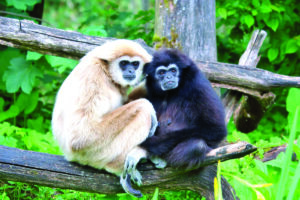By Dr. Beth Leermakers
Dinner. Dancing. Red roses. Jewelry. Humans aren’t the only ones who engage in elaborate courtship rituals. From gifts to grand displays, these animals pull out all the stops to impress their mates.
The Way to a Woman’s Heart
Food features prominently in several insects’ mating rituals.
Hangingflies. During courtship and mating, the male hangingfly gives an insect to the female as a nuptial gift. The insect must be large enough to keep the female busy eating while they mate. If the female runs out of food before the male fills her sperm storage organ — about 20 minutes — the female disengages. But if her storage unit fills up before she finishes eating the insect, the male loses interest in mating with her. He takes the leftovers and gives them to another female.
Nursery web spiders. Male nursery web spiders present females with an insect wrapped in silk as a courtship offering to encourage mating. The female examines the gift; if it passes muster, she mates with the male while unwrapping and eating the tasty morsel.
However, some males cheat by substituting a twig or pebble for an insect or by sucking out the food, leaving only the exoskeleton. The silk wrapping may deceive the female initially, but once she realizes the trick, she eats him, abruptly ending the “relationship.”
Not all gifts involve food. While many women prefer jewelry to a blender, birds happily embrace functional presents.
Adelie penguins. A male Adelie penguin, living in the Antarctic, offers rare rocks to his chosen mate, who uses them to line her nest. If the female approves of the rocks, she allows him to mate with her.
However, if the male leaves and another suitor gives her a desirable rock, she will mate with him as well.
Dancing Queens (and Kings)
Usually performed by males to attract females, dancing is a common courtship ritual in the animal kingdom. In some animal species, females dance to capture attention, or males and females dance together.
Gibbons. Gibbons are the only species closely related to humans that form long term, monogamous pair bonds. Gibbon mates often sing a complex duet to ward off other gibbons who are looking for a home. Sexually mature female gibbons perform rhythmic, robotic dances to capture attention. In the wild, these dances are primarily tied to mating, while in captivity, they also serve as a means of social interaction or to request grooming. Interestingly, the female gibbon frequently glances over her shoulder to make sure someone is watching her act.

Bald eagles. Bald eagles take dancing to a whole other level — literally. They engage in a “cartwheel courtship flight” that involves a pair of eagles flying high, locking talons and soaring down to the earth while spinning in a cartwheel-like fashion, separating at the last possible moment. Eagles, who typically mate for life, also bond by picking out nest materials together — like shopping at Crate and Barrel. They collect sticks and soft materials like grass and pine straw to make the egg cups that insulate their developing eggs.
Seeking a Mate
Who Can Decorate
Some birds are looking for a mate who can create a comfortable, beautiful home (on a budget, no less).
Bowerbirds. Female bowerbirds are impressed by dancing and decorating skills. During courtship, male satin bowerbirds build nuptial bowers (think towers of sticks) and adorn them with only blue objects, including man-made items such as ribbon or plastic. The females inspect the bowers (like going to open houses). If the female likes the bowerbird’s creation, the male must dance for her to win her affection. Researchers placed red objects on some bowers and learned that female bowerbirds prefer the males who were smart enough to remove the red items.
Whatever your Valentine has in store for you, be grateful that it doesn’t involve a silk-wrapped insect.
Happy Valentine’s Day!
